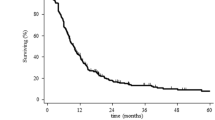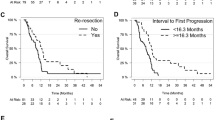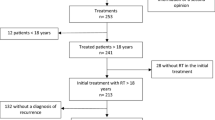Abstract
Purpose
To report survival outcomes and identify prognostic factors of salvage re-irradiation (re-RT) in recurrent/progressive glioma.
Methods
Medical records of patients treated with high-dose re-RT as part of multi-modality salvage therapy for recurrence/progression of adult diffuse glioma from 2010 to 2019 were analyzed retrospectively.
Results
A total of 111 patients developing recurrent/progressive high-grade glioma after adequate upfront treatment at initial diagnosis were included. The first course of radiotherapy (RT) had been delivered to a median dose of 59.4 Gy with an inter-quartile range (IQR) of 54-60 Gy. Median time to recurrence/progression was 4.3 years (IQR = 2.3–7.4 years) while the median time to re-RT was 4.8 years (IQR = 3.6–7.9 years). Re-RT was delivered with intensity-modulated radiation therapy (IMRT) using 1.8 Gy/fraction to a median dose of 54 Gy (IQR = 50.4–55.8 Gy) for a cumulative median equivalent dose in 2-Gy fractions (EQD2) of 104.3 Gy (IQR = 102.6–109.4 Gy). At a median follow-up of 14 months after re-RT, the 1-year Kaplan–Meier estimates of post-re-RT progression-free survival (PFS) and overall survival (OS) were 42.8 and 61.8%, respectively. Univariate analysis identified histological grade at recurrence/progression; histological subtype; disease-free interval (DFI) and time interval between both courses of RT; performance status at re-RT; dose at re-RT and cumulative EQD2; isocitrate dehydrogenase (IDH) mutation; and O6-methyl-guanine DNA methyl transferase (MGMT) gene promoter methylation as significant prognostic factors. Preserved performance status, longer DFI, prolonged time interval between both courses of RT, and presence of IDH mutation were associated with significantly improved PFS on multi-variate analysis. However, only performance status retained independent prognostic significance for OS on multi-variate analysis. Post-treatment changes were seen in 33 (30%) patients on follow-up imaging, with higher cumulative dose (EQD2 ≥ 104.3 Gy) being associated with increased risk of post-re-RT pseudo-progression.
Conclusion
This clinical audit reports encouraging survival outcomes and identifies key prognostic factors associated with high-dose salvage re-RT in recurrent/progressive glioma.


Similar content being viewed by others
References
Ostrom QT, Cioffi G, Gittleman H, Patil N, Waite K, Kruchko C, et al. CBTRUS statistical report: primary brain and other central nervous system tumors diagnosed in the United States in 2012–2016. Neuro Oncol. 2019;21:v1-100. https://doi.org/10.1093/neuonc/noz150.
Louis DN, Ohgaki H, Wiestler OD, Cavenee WK, Burger PC, Jouvet A, et al. The 2007 WHO classification of tumours of the central nervous system. Acta Neuropathol. 2007;114:97–109. https://doi.org/10.1007/s00401-007-0243-4.
Berrocal A, Gil M, Gallego O, Balana C, Segura PP, Garcia-Mata J, et al. SEOM guideline for the treatment of malignant glioma. Clin Transl Oncol. 2012;14:545–50. https://doi.org/10.1007/s12094-012-0839-6.
Stupp R, Brada M, van den Bent MJ, Tonn JC, Pentheroudakis G. High-grade glioma: ESMO clinical practice guidelines for diagnosis, treatment and follow-up. Ann Oncol. 2014;25:93–101. https://doi.org/10.1093/annonc/mdu050.
Kirkpatrick JP, Sampson JH. Recurrent Malignant Gliomas. Semin Radiat Oncol. 2014;24:289–98. https://doi.org/10.1016/j.semradonc.2014.06.006.
Niyazi M, Siefert A, Schwarz SB, Ganswindt U, Kreth F-W, Tonn J-C, et al. Therapeutic options for recurrent malignant glioma. Radiother Oncol. 2011;98:1–14. https://doi.org/10.1016/j.radonc.2010.11.006.
Birk HS, Han SJ, Butowski NA. Treatment options for recurrent high-grade gliomas. CNS Oncol. 2017;6:61–70. https://doi.org/10.2217/cns-2016-0013.
Lee J, Cho J, Chang JH, Suh CO. Re-Irradiation for recurrent gliomas: treatment outcomes and prognostic factors. Yonsei Med J. 2016;57(4):824–30. https://doi.org/10.3349/ymj.2016.57.4.824.
Klobukowski L, Falkov A, Chelimo C, Fogh SE. A retrospective review of re-irradiating patients’ recurrent high-grade gliomas. Clin Oncol. 2018;30(9):563–70. https://doi.org/10.1016/j.clon.2018.05.004.
Maitre P, Gupta T, Maitre M, Goda J, Krishnatry R, Chatterjee A, et al. Prospective longitudinal assessment of quality of life and activities of daily living as patient-reported outcome measures in recurrent/rogressive glioma treated with high-dose salvage re-irradiation. Clin Oncol. 2020. https://doi.org/10.1016/j.clon.2020.08.011.
Yeole U, Arimappamagan A. Role of surgery in recurrent high-grade glioma: current evidence. Int J Neurooncol. 2020;3:1–7. https://doi.org/10.4103/IJNO.IJNO_7_20.
Palmer JD, Siglin J, Yamoah K, Dan T, Champ CE, Bar-Ad V, et al. Re-resection for recurrent high-grade glioma in the setting of re-irradiation: more is not always better. J Neurooncol. 2015;124(2):215–21. https://doi.org/10.1007/s11060-015-1825-y.
Wei W, Chen X, Ma X, Wang D, Guo Z. The efficacy and safety of various dose-dense regimens of temozolomide for recurrent high-grade glioma: systematic review and meta-analysis. J Neurooncol. 2015;125(2):339–49. https://doi.org/10.1007/s11060-015-1920-0.
Shi W, Scannell Bryan M, Gilbert MR, Mehta MP, Blumenthal DT, Brown PD, et al. Investigating the effect of reirradiation or systemic therapy in patients with glioblastoma after tumor progression: a secondary analysis of NRG Oncology/Radiation Therapy Oncology Group Trial 0525. Int J Radiat Oncol. 2018;100:38–44. https://doi.org/10.1016/j.ijrobp.2017.08.038.
Shanker M, Chua B, Bettington C, Foote MC, Pinkham MB. Re-irradiation for recurrent high-grade gliomas: a systematic review and analysis of treatment technique with respect to survival and risk of radionecrosis. Neuro-Oncology Pract. 2019;6:144–55. https://doi.org/10.1093/nop/npy019.
Kazmi F, Soon YY, Leong YH, Koh WY, Vellayappan B. Re-irradiation for recurrent glioblastoma (GBM): a systematic review and meta-analysis. J Neurooncol. 2019;142:79–90. https://doi.org/10.1007/s11060-018-03064-0.
Ruifrok AC, van der Kogel AJ. A “reappraisal” of the LQ model for the understanding of dose-fractionation in radiotherapy. Int J Radiat Oncol Biol Phys. 1993;25:926–9. https://doi.org/10.1016/0360-3016(93)90328-s.
Krauze AV, Attia A, Braunstein S, Chan M, Combs SE, Fietkau R, et al. Expert consensus on re-irradiation for recurrent glioma. Radiat Oncol. 2017;12:194. https://doi.org/10.1186/s13014-017-0928-3.
Shen CJ, Kummerlowe MN, Redmond KJ, Martinez-Gutierrez JC, Usama SM, Holdhoff M, et al. Re-irradiation for malignant glioma: Toward patient selection and defining treatment parameters for salvage. Adv Radiat Oncol. 2018;3:582–90. https://doi.org/10.1016/j.adro.2018.06.005.
Arvold ND, Shi DD, Aizer AA, Norden AD, Reardon DA, Lee EQ, et al. Salvage re-irradiation for recurrent high-grade glioma and comparison to bevacizumab alone. J Neurooncol. 2017;135:581–91. https://doi.org/10.1007/s11060-017-2611-9.
Hundsberger T, Brugge D, Putora PM, Weder P, Weber J, Plasswilm L. Re-irradiation with and without bevacizumab as salvage therapy for recurrent or progressive high-grade gliomas. J Neurooncol. 2013;112(1):133–9. https://doi.org/10.1007/s11060-013-1044-3.
Palmer JD, Bhamidipati D, Song A, Eldredge-Hindy HB, Siglin J, Dan TD, et al. Bevacizumab and re-irradiation for recurrent high grade gliomas: does sequence matter? J Neurooncol. 2018;140:623–8. https://doi.org/10.1007/s11060-018-2989-z.
Schernberg A, Dhermain F, Ammari S, Dumont SN, Domont J, Patrikidou A, et al. Reirradiation with concurrent bevacizumab for recurrent high-grade gliomas in adult patients. Cancer. 2018;22:9–16. https://doi.org/10.1016/j.canrad.2017.06.013.
Bergman D, Modh A, Schultz L, Snyder J, Mikkelsen T, Shah M, et al. Randomized prospective trial of fractionated stereotactic radiosurgery with chemotherapy versus chemotherapy alone for bevacizumab-resistant high-grade glioma. J Neurooncol. 2020;148:353–61. https://doi.org/10.1007/s11060-020-03526-4.
Tsien C, Pugh S, Dicker AP, Raizer JJ, Matuszak MM, Lallana E, et al. Randomized phase ii trial of re-irradiation and concurrent bevacizumab versus bevacizumab alone as treatment for recurrent glioblastoma (NRG Oncology/RTOG 1205): initial outcomes and RT plan quality report. Int J Radiat Oncol Biol Phys. 2019;105:S78. https://doi.org/10.1016/j.ijrobp.2019.06.539.
Fleischmann DF, Jenn J, Corradini S, Ruf V, Herms J, Forbrig R, et al. Bevacizumab reduces toxicity of reirradiation in recurrent high-grade glioma. Radiother Oncol. 2019;138:99–105. https://doi.org/10.1016/j.radonc.2019.06.009.
Balana C, Etxaniz O, Buges C, Martinez A. Approval denided by European Medicines Agency (EMA) for bevacizumab in the treatment of high-grade glioma recurrence: a good idea or a grave error. Clin Transl Oncol. 2011;13:209. https://doi.org/10.1007/s12094-011-0642-9.
Back M, Gzell CE, Kastelan M, Guo L, Wheeler HR. Large volume re-irradiation with bevacizumab is a feasible salvage option for patients with refractory high-grade glioma. Neuro-Oncology Pract. 2015;2:48–53. https://doi.org/10.1093/nop/npu031.
Combs SE, Edler L, Rausch R, Welzel T, Wick W, Debus J. Generation and validation of a prognostic score to predict outcome after re-irradiation of recurrent glioma. Acta Oncol. 2013;52:147–52. https://doi.org/10.3109/0284186X.2012.692882.
Kessel KA, Hesse J, Straube C, Zimmer C, Schmidt-Graf F, Schlegel J, et al. Validation of an established prognostic score after re-irradiation of recurrent glioma. Acta Oncol (Madr). 2017;56:422–6. https://doi.org/10.1080/0284186X.2016.1276621.
Krauze AV, Peters C, Cheng J, Ning H, Mackey M, Rowe L, et al. Re-irradiation for recurrent glioma—the NCI experience in tumor control, OAR toxicity and proposal of a novel prognostic scoring system. Radiat Oncol. 2017;12:1–10. https://doi.org/10.1186/s13014-017-0930-9.
Niyazi M, Adeberg S, Kaul D, Boulesteix AL, Bougatf N, Fleischmann DF, et al. Independent validation of a new reirradiation risk score (RRRS) for glioma patients predicting post-recurrence survival: a multicenter DKTK/ROG analysis. Radiother Oncol. 2018;127:121–7. https://doi.org/10.1016/j.radonc.2018.01.011.
Chapman CH, Hara JH, Molinaro AM, Clarke JL, Oberheim Bush NA, Taylor JW, et al. Reirradiation of recurrent high-grade glioma and development of prognostic scores for progression and survival. Neuro-Oncology Pract. 2019. https://doi.org/10.1093/nop/npz017.
Molinaro AM, Taylor JW, Wiencke JK, Wrensch MR. Genetic and molecular epidemiology of adult diffuse glioma. Nat Rev Neurol. 2019;15:405–17. https://doi.org/10.1038/s41582-019-0220-2.
Delga-Lopez PD, Saiz-Lopez P, Gargini R, Sola-Vendrell E, Tejada S. A comprehensive overview of the molecular biology of humar glioma: what the clinician needs to know. Clin Transl Oncol. 2020;22:1909–22. https://doi.org/10.1007/s12094-020-02340-8.
Collins VP, Ichimura K, Di Y, Pearson D, Chan R, Thompson LC, et al. Prognostic and predictive markers in recurrent high grade glioma; results from the BR12 randomised trial. Acta Neuropathol Commun. 2014;2:1–15. https://doi.org/10.1186/2051-5960-2-68.
Wen PY, Macdonald DR, Reardon DA, Cloughesy TF, Sorensen AG, Galanis E, et al. Updated response assessment criteria for high-grade gliomas: response assessment in neuro-oncology working group. J Clin Oncol. 2010;28(11):1963–72. https://doi.org/10.1200/JCO.2009.26.3541.
Mayer R, Sminia P. Re-irradiation tolerance of the human brain. Int J Radiat Oncol Biol Phys. 2008;70(5):1350–60. https://doi.org/10.1016/j.ijrobp.2007.08.015.
Sminia P, Mayer R. External beam radiotherapy of recurrent glioma: Radiation tolerance of the human brain. Cancers. 2012;4:379–99. https://doi.org/10.3390/cancers4020379.
Ho ALK, Jena R. Re-irradiation in the brain: primary gliomas. Clin Oncol. 2018;30:124–36. https://doi.org/10.1016/j.clon.2017.11.006.
Funding
No funding was involved in this study.
Author information
Authors and Affiliations
Corresponding author
Ethics declarations
Conflict of interest
The authors declare that they have no conflict of interest.
Ethical approval
The study was duly reviewed and approved by the Institutional Ethics Committee (IEC) and waiver of consent was granted by IEC owing to the retrospective nature of the study with less than minimal risk to participants.
Additional information
Publisher's Note
Springer Nature remains neutral with regard to jurisdictional claims in published maps and institutional affiliations.
Rights and permissions
About this article
Cite this article
Gupta, T., Maitre, M., Maitre, P. et al. High-dose salvage re-irradiation for recurrent/progressive adult diffuse glioma: healing or hurting?. Clin Transl Oncol 23, 1358–1367 (2021). https://doi.org/10.1007/s12094-020-02526-0
Received:
Accepted:
Published:
Issue Date:
DOI: https://doi.org/10.1007/s12094-020-02526-0




